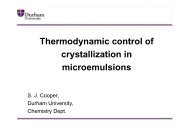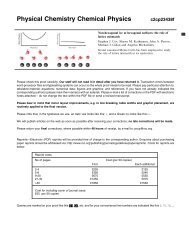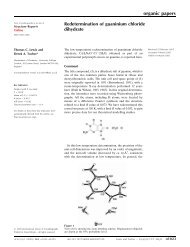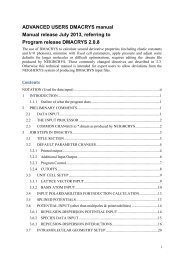An Introduction to the Theory of Crystalline Elemental Solids and ...
An Introduction to the Theory of Crystalline Elemental Solids and ...
An Introduction to the Theory of Crystalline Elemental Solids and ...
You also want an ePaper? Increase the reach of your titles
YUMPU automatically turns print PDFs into web optimized ePapers that Google loves.
30<br />
FIG. 15: Side view <strong>of</strong> <strong>the</strong> π-bonded chain model for <strong>the</strong> (111) surface <strong>of</strong> <strong>the</strong> group IV elements<br />
in <strong>the</strong> diamond lattice <strong>and</strong> how it can be transformed in <strong>to</strong> two related structures known as <strong>the</strong><br />
“chain-left” or “chain-high” <strong>and</strong> “chain-right” or “chain-low” isomers. After ref. [107].<br />
<strong>the</strong> [110] direction connected <strong>to</strong> <strong>the</strong> subsurface a<strong>to</strong>ms by 5- <strong>and</strong> 7-membered rings, as<br />
opposed <strong>to</strong> <strong>the</strong> 6-membered rings <strong>of</strong> <strong>the</strong> bulk structure. This zig-zag chain model for<br />
<strong>the</strong> (2×1) reconstruction <strong>of</strong> <strong>the</strong> (111) surface <strong>of</strong> <strong>the</strong> diamond lattice is known as <strong>the</strong><br />
“π-bonded chain model ”. In <strong>the</strong> original π-bonded chain model, due <strong>to</strong> P<strong>and</strong>ey [118],<br />
all <strong>the</strong> <strong>to</strong>p layer Si a<strong>to</strong>ms in <strong>the</strong> π-bonded chains reside at <strong>the</strong> same height. However,<br />
like <strong>the</strong> situation just discussed for <strong>the</strong> Si dimers <strong>of</strong> <strong>the</strong> (100)-(2×1) reconstruction, <strong>the</strong><br />
a<strong>to</strong>ms in <strong>the</strong> π-bonded chains are liable <strong>to</strong> buckle. Specifically one can generate two<br />
analogue structures by titling <strong>the</strong> <strong>the</strong> two a<strong>to</strong>ms <strong>of</strong> <strong>the</strong> chain in clockwise or anticlockwise<br />
directions. How <strong>the</strong> two resulting structures, <strong>the</strong> so-called “chain-high” or “chain-left”<br />
<strong>and</strong> “chain-low” or “chain-right” structures are generated is illustrated in Fig. 15. For<br />
Ge(111)-(2×1) <strong>the</strong> anticlockwise chain-high isomer is favored. For Si(111)-(2×1) both <strong>the</strong><br />
chain high <strong>and</strong> chain low structure are almost degenerate in energy <strong>and</strong> for C(111)-(2×1)<br />
no buckling is found. For a fuller discussion focussing on <strong>the</strong> physical origin <strong>of</strong> <strong>the</strong><br />
buckling <strong>the</strong> interested reader is referred <strong>to</strong> <strong>the</strong> book <strong>of</strong> Bechstedt [107].<br />
5.3 Surface Structure Summary<br />
To conclude our discussion on semiconduc<strong>to</strong>r <strong>and</strong> metal surface structures, <strong>the</strong>se surfaces<br />
tend not <strong>to</strong> retain <strong>the</strong>ir bulk-truncated structures <strong>and</strong> a huge variety <strong>of</strong> relaxations <strong>and</strong><br />
reconstructions are possible. The interested reader may wish <strong>to</strong> refer <strong>to</strong> Tables 2.3a <strong>and</strong><br />
2.3b <strong>of</strong> Somorjai’s textbook on surface chemistry for a more extensive overview <strong>of</strong> <strong>the</strong><br />
many <strong>and</strong> varied structures clean solid surfaces can adopt [72].<br />
6. Surface Energetics<br />
6.1 <strong>Introduction</strong> <strong>and</strong> Experimental Considerations<br />
The energy <strong>to</strong> make a surface at a given temperature <strong>and</strong> pressure is <strong>the</strong> Gibbs surface<br />
free energy, G S . The Gibbs surface free energy thus determines <strong>the</strong> surface that will form<br />
under real world everyday conditions, <strong>and</strong> can be defined by <strong>the</strong> relation<br />
G = NG 0 + AG S , (32)







